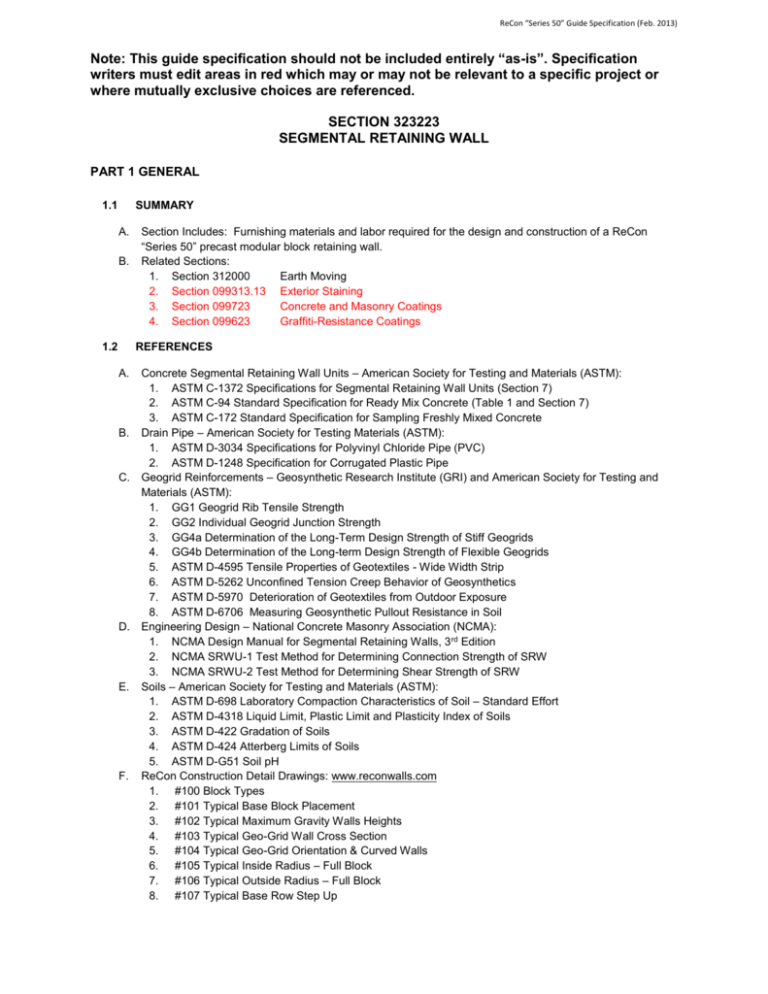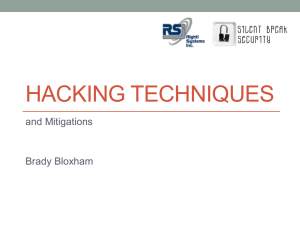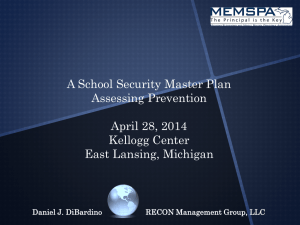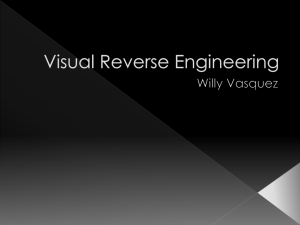Microsoft Word Format - ReCon Wall Systems, Inc
advertisement

ReCon “Series 50” Guide Specification (Feb. 2013) Note: This guide specification should not be included entirely “as-is”. Specification writers must edit areas in red which may or may not be relevant to a specific project or where mutually exclusive choices are referenced. SECTION 323223 SEGMENTAL RETAINING WALL PART 1 GENERAL 1.1 SUMMARY A. B. 1.2 Section Includes: Furnishing materials and labor required for the design and construction of a ReCon “Series 50” precast modular block retaining wall. Related Sections: 1. Section 312000 Earth Moving 2. Section 099313.13 Exterior Staining 3. Section 099723 Concrete and Masonry Coatings 4. Section 099623 Graffiti-Resistance Coatings REFERENCES A. B. C. D. E. F. Concrete Segmental Retaining Wall Units – American Society for Testing and Materials (ASTM): 1. ASTM C-1372 Specifications for Segmental Retaining Wall Units (Section 7) 2. ASTM C-94 Standard Specification for Ready Mix Concrete (Table 1 and Section 7) 3. ASTM C-172 Standard Specification for Sampling Freshly Mixed Concrete Drain Pipe – American Society for Testing Materials (ASTM): 1. ASTM D-3034 Specifications for Polyvinyl Chloride Pipe (PVC) 2. ASTM D-1248 Specification for Corrugated Plastic Pipe Geogrid Reinforcements – Geosynthetic Research Institute (GRI) and American Society for Testing and Materials (ASTM): 1. GG1 Geogrid Rib Tensile Strength 2. GG2 Individual Geogrid Junction Strength 3. GG4a Determination of the Long-Term Design Strength of Stiff Geogrids 4. GG4b Determination of the Long-term Design Strength of Flexible Geogrids 5. ASTM D-4595 Tensile Properties of Geotextiles - Wide Width Strip 6. ASTM D-5262 Unconfined Tension Creep Behavior of Geosynthetics 7. ASTM D-5970 Deterioration of Geotextiles from Outdoor Exposure 8. ASTM D-6706 Measuring Geosynthetic Pullout Resistance in Soil Engineering Design – National Concrete Masonry Association (NCMA): 1. NCMA Design Manual for Segmental Retaining Walls, 3 rd Edition 2. NCMA SRWU-1 Test Method for Determining Connection Strength of SRW 3. NCMA SRWU-2 Test Method for Determining Shear Strength of SRW Soils – American Society for Testing and Materials (ASTM): 1. ASTM D-698 Laboratory Compaction Characteristics of Soil – Standard Effort 2. ASTM D-4318 Liquid Limit, Plastic Limit and Plasticity Index of Soils 3. ASTM D-422 Gradation of Soils 4. ASTM D-424 Atterberg Limits of Soils 5. ASTM D-G51 Soil pH ReCon Construction Detail Drawings: www.reconwalls.com 1. #100 Block Types 2. #101 Typical Base Block Placement 3. #102 Typical Maximum Gravity Walls Heights 4. #103 Typical Geo-Grid Wall Cross Section 5. #104 Typical Geo-Grid Orientation & Curved Walls 6. #105 Typical Inside Radius – Full Block 7. #106 Typical Outside Radius – Full Block 8. #107 Typical Base Row Step Up ReCon “Series 50” Guide Specification (Feb. 2013) 9. 10. 11. 12. 13. 14. 15. 16. 17. 18. 19. 20. 21. 22. 23. 24. 25. 26. 27. 28. 29. 1.3 #108 Typical Top of Wall Step Up #109 Typical Top of Wall Step Up – Alternative Placement #110 Typical Outside Corner Detail #111 Typical Inside Corner Detail #112 Outside Corner Details – Double & Single 90° Corners Abutting to Vertical Structures #113 Typical Guard Rail Detail #114 Typical Fence Detail #115 Typical Water Wall Detail #116 Typical Drain Tile Detail #117 Box Culvert Headwall Grid #118 Box Culvert Headwall Gravity #119 Box Culvert Wing Wall Grid #120 Box Culvert Wing Wall Gravity #121 Oblique Inside Corner Standard #122 Oblique Inside Corner Special #123 Oblique Outside Corner Standard #124 Oblique Outside Corner Special #125 Double Stacked Half Block #200 Capstone Unit Details #201 Step Block #301 Full High Cap Block DEFINITIONS A. ReCon Retaining Wall Unit: Concrete, segmental facing block provided by an authorized manufacturer under license to ReCon Retaining Wall Systems, Inc. B. Geogrid: A geosynthetic material manufactured of high tensile materials specifically for the purpose of reinforcing and creating a structural soil mass. C. Drainage Aggregate: Clean, crushed rock located within and immediately behind ReCon units to facilitate drainage and avoid compaction in close proximity to ReCon wall units. D. Reinforced Backfill: Soil zone extending from the Drainage aggregate zone to the back of the embedded geogrid. E. Foundation Soil: Soil zone immediately beneath the retaining wall facing units, the wall leveling pad and the reinforced soil zone. F. Retained Soil: Soil immediately behind retaining wall facing and drainage aggregate or reinforced backfill if present. G. Construction Drawings: Approved final plan for construction prepared and stamped by the wall design engineer licensed to practice in the state where the retaining wall is located. 1.4 Submittals A. B. C. Contractor shall submit Manufacturer’s product data and installation instructions for approval. Contractor shall submit Manufacturer’s test reports certifying that the ReCon units manufactured at their production facility meet the requirements of this specification and the requirements of the Construction Drawings. Unless provided within these project documents and/or the project drawings, contractor shall submit two sets of the Construction Drawings for all ReCon retaining walls on the project. 1. The design shall be prepared by a Professional Engineer licensed to practice in the state where the retaining wall is located. 2. The design shall be per NCMA Design Guidelines for Segmental Retaining Walls, or the AASHTO Standard Specifications for Highway Bridges, whichever is applicable as determined by the retaining wall design engineer. 3. Construction Drawings shall include: a. The retaining wall layout and retaining wall heights. b. Proper placement, lengths and types of geogrid reinforcement where necessary. c. Typical wall sections. ReCon “Series 50” Guide Specification (Feb. 2013) D. E. F. 1.5 d. Types, locations and properties of all drainage materials, appurtenances and special installation requirements not covered in this specification. e. Retaining wall elevation views. f. Any soils reports or testing conducted in addition to that included within the project drawings and specifications. g. Design assumptions. If geogrid reinforcement is required in the final engineered construction drawings, submit manufacturer’s product literature, product testing reports and a twelve inch or larger sample of each type to be used in wall construction. 1. Testing Reports shall include: a. Connection strength data for each combination of ReCon segmental unit and geogrid used as determined by NCMA SRWU-1. b. Long-term design strength as determined by GG4-91. c. Geogrid soil pullout as determined by ASTM D-6706. Submit gradation reports for aggregates used for the wall leveling pad, unit / drainage fill and for select reinforced fill if required in the final engineered wall design. All submittals must be provided and reviewed prior to the start of retaining wall construction. DELIVERY, STORAGE, AND HANDLING A. B. C. D. 1.6 Contractor shall inspect all products at delivery to determine that the proper materials have been delivered and are usable. Damaged material shall not be incorporated into the work. ReCon retaining wall units shall be stored in a location and manner that protects against excessive weathering and damage. Contractor shall prevent ReCon units from excessive soiling and coming in contact with substances which may stain or adhere to the finished visual surfaces of the unit. Faces of the ReCon Block shall be free of excessive chipping, cracking and stains. QUALITY ASSURANCE A. B. Installer Qualifications: Contractor shall have successfully installed at least three projects similar to that of this project within the last two years. Contractor shall maintain at least one mechanic on site at all times that worked on one or more of these previous installations. Owner shall employ the services of an independent geotechnical or materials engineering firm to provide soil testing and quality assurance inspection for wall construction and soils work. Contractor shall provide any quality control testing or inspection not provided by the Owner. PART 2 PRODUCTS 2.1 MANUFACTURERS A. Only licensed and authorized manufacturers of: 1. ReCon Wall Systems, Inc. 7600 West 27th St., #229 St Louis Park, MN 55426 (952) 922-0027 Phone (952) 922-0028 Fax www.reconwalls.com ReCon “Series 50” Guide Specification (Feb. 2013) 2.2 MATERIALS ReCon “Series 50” retaining wall units. 1. The block unit shall consist of concrete with the average 28-day compressive strength of no less than 4000 PSI. 2. Concrete shall have air entrainment by volume (as measured in the plastic state in accordance with ASTM C172) of: a. 5.5 – 8.5 percent, or b. In conformity with ASTM C94 (Table 1 and Section 7), latest revision. 3. Exterior dimensions of the face shall be 48” by 16” for full and corner unit, and 24” by 16” for half unit. 4. Depth of unit should be as per Construction Drawings and is available in depths from 24” up to 84” (24”, 39”, 45”, 60”, 66”, 72”, 78”, 84”). 5. ReCon Units used shall maintain tolerances of: a. Height: +/- 3/16” b. Width: +/- 1/2" unless field cut for fitting purposes. c. Depth: No less than the unit design depth (i.e. 24”, 39”, 45”, 60”, 66”, 72”, 78” or 84”) with the textured face portion of the block is considered as 4” 6. Special shape units should be obtained and used where indicated on the final engineered construction drawings. Reference ReCon Drawing #100 for overview of standard unit types. 7. ReCon Unit Face Texture [Specify choice (or choices) as required. Check local availability]: a. Shall be “LeSueur County Limestone” <or> b. Shall be “North Shore Granite” <or> c. Shall be “Old World” <or> d. Shall be “Rustic” <or> e. Shall be Weathered Edge” B. Geogrid Reinforcement: Geosynthetic reinforcement shall be high tensile geogrid or geotextile manufactured specifically for soil reinforcement applications. 1. Construction Drawings shall indicate the type, strength, location and lengths of reinforcement used. 2. The geosynthetic manufacturer shall provide all relevant testing to the wall design engineer for incorporation in the wall design and shall be included in the submittal for the Construction Drawings. 3. No substitutions of geosynthetic shall be allowed that was not evaluated in the Construction Drawings. C. Base Leveling Pad: The wall base leveling pad material shall consist of a compacted crushed stone base or non-reinforced concrete as indicated in the Construction Drawings. D. Drainage Aggregate: Drainage aggregate shall consist of clean 1” minus crushed stone or gravel meeting the requirements of the Construction Drawings. E. Backfill Material: All backfill material, borrow or imported, shall meet all requirements of the Construction Drawings. F. Drainage Pipe: If required in Construction Drawings, drainage pipe shall be perforated or slotted PVC pipe manufactured in accordance with ASTM D-3034 or corrugated HDPE pipe manufactured in accordance with ASTM D-1248. Drainage pipe may also be covered with a geotextile filter fabric. G. Unit Adhesive: Adhesive shall be a premium, construction grade suitable for concrete and exterior applications. A. 2.3 FINISHES A. ReCon retaining wall color [Specify choice (or color) as required] 1. Finished wall shall be left in natural (as-cast) color. <or> 2. Finished retaining wall shall be stained in accordance with Section 099313.13 “Exterior Staining”. a. Acceptable product stains: 1. Sherwin Williams H & C SHIELD PLUS CONCRETE STAIN ReCon “Series 50” Guide Specification (Feb. 2013) 2. TK Products TRI-SHEEN PIGMENTED STAIN TK-5272 b. Color shall match [Define reference or sample to match] <or> c. Color shall be [Designate existing color] 3. Sealing [Optional, list here and specify in Section 099723 Concrete and Masonry Coatings or 099623 Graffiti Resistant Coatings] a. Acceptable sealers and anti-graffiti coatings 1. TK Products TK-290 Tri-SILOXANE OTC (sealer) 2. TK Products 1496 TK Prermaclean OTC (anti-graffiti) PART 3 EXECUTION 3.1 EXAMINATION A. B. C. 3.2 Verify locations of utilities and existing structures prior to excavation. Examine the Project site and evaluate conditions where the ReCon retaining wall will be constructed. Notify the proper supervising authority in writing of any conditions that may interfere with the proper construction of the ReCon wall or delay completion. Promptly notify the wall design engineer of site conditions which may affect wall performance, soil conditions observed other than those assumed, or other conditions that may require a reevaluation of the wall design. EXCAVATION A. B. C. 3.3 Contractor shall excavate to the lines and grades shown on the construction drawings. The contractor shall be careful not to disturb the base beyond the lines indicated. Foundation soils shall be excavated as required for footing base / leveling pad dimensions shown on the construction drawings, or as directed by the wall engineer. Over-excavated areas shall be filled with suitable base or backfill material and compacted to 95% standard proctor. FOUNDATION SOILS PREPARATION A. B. 3.4 Foundation soils shall be evaluated by a Geotechnical Engineer or Owners Representative to ensure that the bearing soils meet or exceed the design conditions or assumptions. Compact foundation soil zone to 95% standard proctor prior to installing base / leveling pad. BASE / LEVELING PAD A. Base shall be located as indicated on the Construction Drawings and shall have a minimum thickness of 6 inches. Base materials are to be as specified by the wall engineer (generally crushed stone, ¾” minus, or similar). B. Width of the base pad must extend a minimum of 6 inches in front and 6 inches in back of the ReCon Base Block footprint. C. Base material shall be compacted so as to provide a smooth, hard surface on which to place the first course of units. D. Compact base material to 95% of standard proctor. E. Base shall be prepared to ensure full contact of the wall unit with base material. Spacing or gaps between units shall no exceed ½”. F. Contractor may elect to substitute a portion of the specified granular base materials with a lean, unreinforced concrete topping. G. When a reinforced footing is required by the Construction Drawings, it shall be located below the frost line. ReCon “Series 50” Guide Specification (Feb. 2013) 3.5 UNIT INSTALLATION A. B. C. D. E. First course of units shall be Base Block units and shall be placed in full contact with the base material. Check units for level from side-to-side, front to back, and check to maintain unit batter front-to-back. Place unit faces in contact side to side and avoid any gaps greater than ½”. Fill and compact fill to grade in front of embedded units prior to compaction behind the wall units. Fill voids between ReCon units with ¾” clean crushed rock to a distance of one foot behind the unit depth unless otherwise instructed in the Construction Drawings. F. Sweep and clean the top of each course before setting additional courses. G. Lay each successive course making sure that the bottom recess is in full contact with the unit locators of the course below. Pull unit forward as far as possible. Backfill and compact soil behind the units. H. Check and maintain level and wall batter by use of shims when necessary. I. Follow ReCon recommended procedures to maintain acceptable running bond when constructing curved walls and / or corners. Build in accordance with Construction Drawings or ReCon Construction Detail Drawings. J. Handle units with proper lifting devices that have been certified for the loads associated with the weights of the units. Avoid applying forces to the lifting loops in excess of the normal force associated with the weight of the unit (i.e., avoid applying “shear forces” or “dynamic loads” from bouncing or swinging of a unit). If the unit is to be transported over a significant distance in the field, it is recommended that a CABLE be used, NOT A CHAIN. The cable has some “stretch” in it that will absorb some of the dynamic loads. 3.6 GEOGRID INSTALLATION Install geosynthetic reinforcement in accordance with manufacturer’s recommendations and the Construction Drawings. B. Locate geosynthetic reinforcement at elevations and to the lengths shown on the Construction Drawings. C. Prior to installation of geosynthetic reinforcement, level and compact backfill material to the level of the reinforcement layer. D. Reinforcement design strength direction must be oriented perpendicular to wall face. E. Position reinforcement on ReCon units over the tongue and groove and to within 2” of the front exposed face. The next course of units shall be placed such that the geogrid is deformed over the tongue and groove. The next course of units must be slid forward such that the back edge of the groove on this unit is up against the back edge of the tongue on the lower unit with the geogrid pinched between the tongue and groove. Hold in place by installing the next course of units. F. Remove all wrinkles or folds in reinforcement by pulling taut prior to backfill placement. Secure using soil staples, stakes or hand tension until reinforcement is covered with sufficient fill to maintain tensioned position. G. Reinforcement shall be continuous throughout the embedment length. Splicing along reinforcement strength direction is not allowed. H. Position reinforcement sections side-by-side to provide 100% coverage along wall face. I. Where curved wall sections cause overlap areas in reinforcement, maintain at least 3” of soil between layers where overlap occurs. A. 3.7 REINFORCED BACKFILL PLACEMENT A. B. C. D. Wall fill material shall be placed in lifts no greater than 8” in depth and shall be less if necessary to achieve necessary compaction. Compact backfill material to 95% of standard proctor. Only hand-operated compaction equipment shall be used within 3 feet of the back of the ReCon units. Wherever possible, backfill should be placed beginning at the face of the wall. Backfill shall be placed, spread, and compacted in a manner that minimizes the development of wrinkles, folds or movement of geogrid. ReCon “Series 50” Guide Specification (Feb. 2013) E. Tracked construction equipment shall not be operated directly on the geogrid. A minimum backfill thickness of 6 inches is required prior to operation of tracked vehicles over the geogrid. Turning of tracked vehicles should be kept to a minimum to prevent tracks from displacing the fill and damaging the geogrid. F. Rubber tired equipment may pass over the geogrid reinforcement at slow speeds, (less than 10 MPH). Avoid sudden braking and sharp turning. G. At the conclusion of each days work, slope backfill at both the crest and bottom of wall away from wall face to prevent surface drainage from scouring or ponding. H. During wall construction, the General Contractor shall be responsible for coordination of other project site operations so as to avoid adjacent construction site drainage from affecting wall construction area. I. Upon completion of wall construction work, the General Contractor shall: 1. Ensure finished grading directs normal drainage away from the finished wall. 2. Ensure other trades do not operate heavy equipment or excavate near the wall and reinforced soil zone. 3.8 OTHER CONSTRUCTION DETAILS A. 3.9 ReCon provides a number of Construction Detail Drawings (see Section 1.2F) which can be found on ReCon’s website (www.reconwalls.com) and should be referred to for guidance on wall specific applications. SITE TOLERANCES A. B. C. 3.10 A. B. C. 3.11 A. B. 3.12 A. B. Straight walls 1. Vertical Alignment: +/- 1.5” over any 12 ft. distance and no more than +/- 3” over the entire length of wall. Horizontal Alignment Control: 2. Corners and radius location: +/- 1 foot to theoretical location indicated on the Grading Plan. 3. Radii: +/- 2 ft. from theoretical lines indicated on the Grading Plan. Wall Batter at Completion of Work: +/- 2 degrees from the design batter and no batter less than 2 degrees. FIELD QUALITY CONTROL Contractor shall be responsible for proper installation and quality control of all ReCon wall components and appurtenant materials. Owner shall, at their expense, retain a qualified professional to monitor and perform quality assurance checks of the installer’s work. Quality Assurance should include foundation soil inspection, frequent backfill compaction testing, verification of geotechnical design parameters and compliance with Construction Drawings and Project Specifications. CLEANING After completion of wall installation, remove construction debris and restore any adjacent finished areas affected by wall construction to their pre-construction state. Wash wall face to remove soiling and stains. Do not use acid or detergents that my “burn” or discolor face. STAINING / SEALING (Optional) Provide samples of stained / sealed faces for approval prior to commencing application to ReCon retaining wall units. Samples shall be large enough to demonstrate scope of color variation. Install stain / sealer in accordance with manufacturers recommended procedures.





